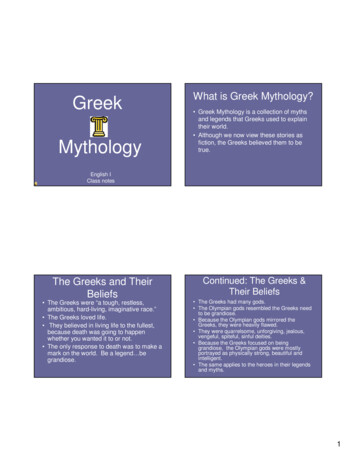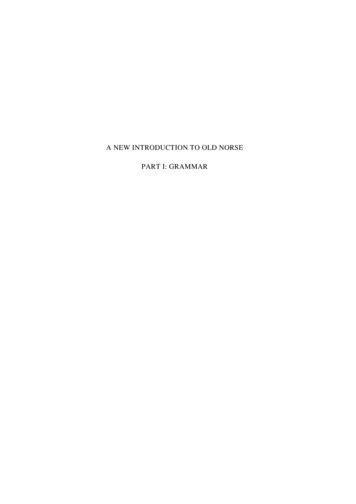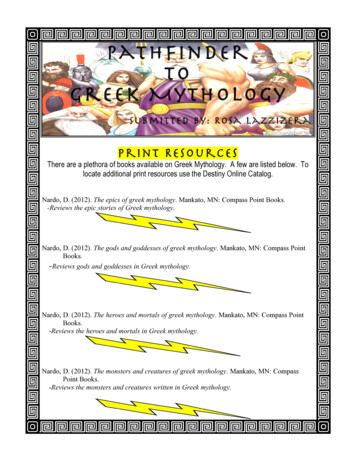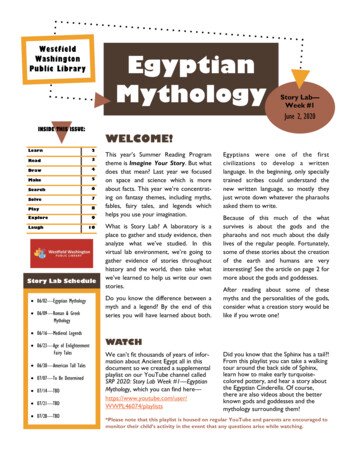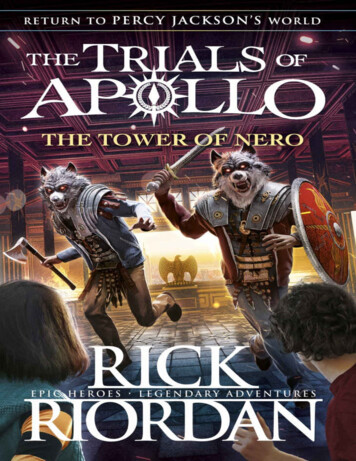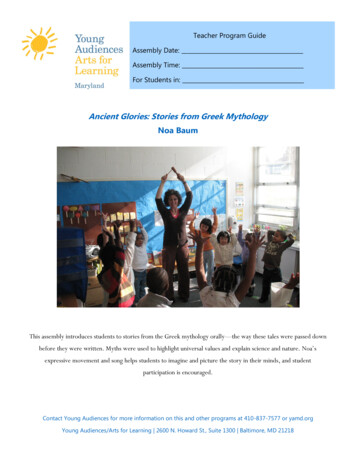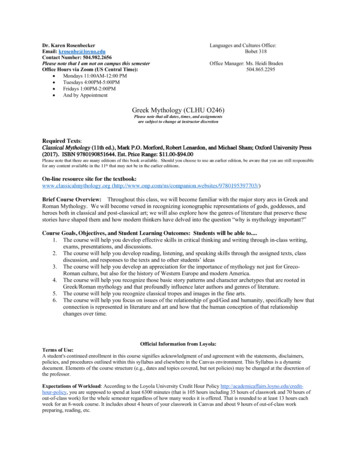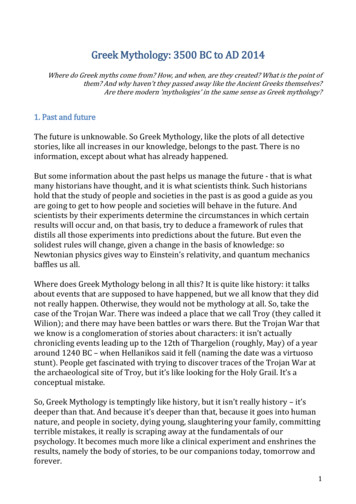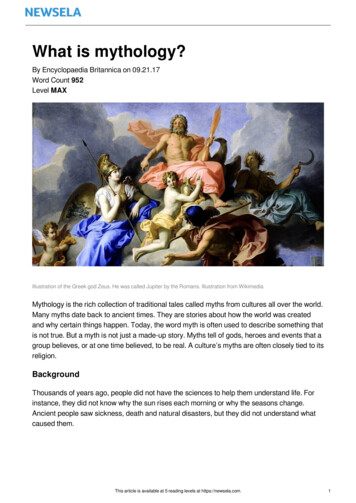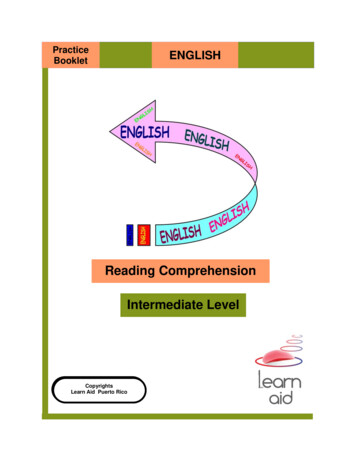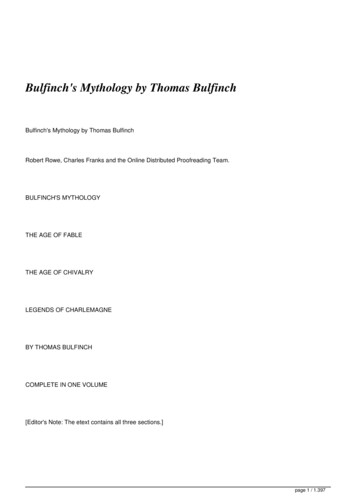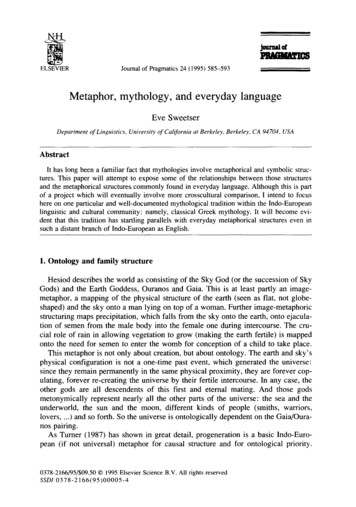
Transcription
jOUl't afELSEVIERJournal of Pragmatics 24 (1995) 585-593Metaphor, mythology, and everyday languageEve S w e e t s e rDepartment of Linguistics, University of California at Berkeley, Berkeley, CA 94704, USAAbstractIt has long been a familiar fact that mythologies involve metaphorical and symbolic structures. This paper will attempt to expose some of the relationships between those structuresand the metaphorical structures commonly found in everyday language. Although this is partof a project which will eventually involve more crosscultural comparison, I intend to focushere on one particular and well-documented mythological tradition within the Indo-Europeanlinguistic and cultural community: namely, classical Greek mythology. It will become evident that this tradition has startling parallels with everyday metaphorical structures even insuch a distant branch of Indo-European as English.1. Ontology and family structureHesiod describes the world as consisting of the Sky God (or the succession of SkyGods) and the Earth Goddess, Ouranos and Gaia. This is at least partly an imagemetaphor, a mapping of the physical structure of the earth (seen as fiat, not globeshaped) and the sky onto a man lying on top of a woman. Further image-metaphoricstructuring maps precipitation, which falls from the sky onto the earth, onto ejaculation of semen from the male body into the female one during intercourse. The crucial role of rain in allowing vegetation to grow (making the earth fertile) is mappedonto the need for semen to enter the womb for conception of a child to take place.This metaphor is not only about creation, but about ontology. The earth and sky'sphysical configuration is not a one-time past event, which generated the universe:since they remain permanently in the same physical proximity, they are forever copulating, forever re-creating the universe by their fertile intercourse. In any case, theother gods are all descendents of this first and eternal mating. And those godsmetonymically represent nearly all the other parts of the universe: the sea and theunderworld, the sun and the moon, different kinds of people (smiths, warriors,lovers . ) and so forth. So the universe is ontologically dependent on the Gaia/Ouranos pairing.As Turner (1987) has shown in great detail, progeneration is a basic Indo-European (if not universal) metaphor for causal structure and for ontological priority.0378-2166/95/ 09.50 1995 Elsevier Science B.V. All rights reservedSSDI 0378-2166(95)00005-4
586E. Sweetser / Journal of Pragmatics 24 (1995) 585-593Children cannot exist without parents causing them to come into existence by intercourse and child-bearing. Parents, of course, have no such causal dependency onchildren. This basic causal link is a metaphor for many less obvious connections. Forexample, humans could not live without an earth and a sky and the rest of the physical structure of the world. But do the earth and the sky seem to need humans to keepgoing? Surely not. Even though this need not mean that the earth and sky actedcausally to bring humans or other parts of the animal/vegetable universe into being,it does mean that there is a one-way dependency relationship. This is the relationshipexpressed by the assumption that earth and sky are PARENTSOF CREATION.Tumer's CAUSATION IS PROGENERATIONmetaphor is profusely manifested in language, outside of mythology. I will give English examples, but Turner has presentedliterary examples from much of Europe and from many different periods. Fromproverbs like "Necessity is the m o t h e r of invention" or poetic examples like " T h ywish was f a t h e r . to that thought" (i.e., wishing caused you to believe the wishwas true), to everyday usages like calling Einstein the "father of modem physics",we regularly represent causal structure in terms of physical progeneration.The family-structure metaphor goes further than just creation as progeneration,however. As Turner points out, family ties can be used as a metaphor for resemblance or relationship between almost anything. Thus, the fact that the Sun, theMoon, and the Sea are members of the same divine family expresses our understanding that they are (1) alike in being eternally present natural phenomena (henceimmortal, not like humans), and (2) interrelated with each other: nature is a harmonious whole made up by different related parts. It also expresses the belief that theircommon eternal ancestors (Earth and Sky) have bequeathed to them their immortalstatus, as mortal children resemble their parents in being mortal. There are furthercausal dependencies to be discerned. People experience the sky with no sun or moonin it, but never the sun or the moon with no sky: this suggests that the sun and mooncannot exist without the sky, while the reverse might not be true: that is, we haveinterpreted the unidirectional correlation as a causal relationship. This causal relationship is appropriately expressed by the fact that the Sun and the Moon aredescended from the Sky, rather than the other way around.Once again, these aspects of kinship metaphors are by no means restricted tomythology. When Hilary Clinton said, "Gennifer Flowers is the daughter of WillieHorton", she was adducing not so much causality as temporal sequence and resemblance between the two cases. As Republicans had used Dukakis' clemency in theHorton case against him (although it was not very relevant to his presidential candidacy), similarly they were using Clinton's none-too-relevant affair with Flowersagainst him. And the Horton incident preceded the Flowers one. She may also havemeant that the success of the Republican publicity in the Horton case had inspiredRepublicans to make public use of the Flowers case, a genuine causal connection.Poetic examples where kinship (especially siblinghood) means similarity abound:"Sleep is the s i s t e r of death" means that it resembles death, not that it is caused byShakespeare, Henry IV, Part Two, IV.v.92.
E. Sweetser / Journal of Pragmatics 24 (1995) 585-593587the same things. And a " g r a n d f a t h e r clause" simply gives special exemptions tocases with temporal priority.2. Cycles of light, growth, and lifeLakoff and Turner (1987) pointed out that one of our most salient metaphors forlife is cycles of light and heat. Thus, life is a day, as in Catullus' famous poem wherehe tells his beloved that once life is over, " T h e r e is one single everlasting nightwhich must be slept". Or life is a year: youth is springtime, old age is winter (onemight call old age someone's "autumn years", and Galsworthy called a happy partof Jolian Forsyte's old age an "Indian Summer"). These, and references to the lunarcycle as well, are structuring metaphors of the Greek mythological corpus.Demeter (the Divine Mother) is a later-generation Earth goddess, sister of the latest-generation Sky god, Zeus (the Divine Father, as we see in his Latin name,Jupiter). She is the cause of the yearly cycle of seasons. Her daughter (or heryounger self), Persephone (or Demeter Kore, Demeter the Maiden) is stolen by theunderworld god of death, and compelled to remain in the underworld as its queen forhalf the year. This half the year is Fall and Winter, while the fertile Summer andSpring happen when Kore is above ground. In the spring, Kore returns and her joyful mother makes the earth fertile again. Besides Kore, there is another Underworldgoddess, Hecate, who is an old crone, rather than a young maiden or a mature fertilewoman. There are thus three separate female figures associated with the Earth, andthese have been seen by analysts as aspects of the same goddess. The youngest,Kore, is a maiden and is associated with spring, when the foliage and grasses areyoung, and often beautifully covered with flowers, but still not bearing ripe fruit.Demeter, the mother, is associated with summer and harvest: the period duringwhich plants bear fruit. And Hecate, the old woman, is associated with the end offall and the winter, when plants die, branches are bare, and there are neither flowersnor fruit.The structure of the agricultural year is thus mapped onto the human life cycle (asit is also with Christ, in Christian ritual). If the Earth is a woman, in a year it goesfrom being a young girl to being an old woman; it presumably dies, and is thenreborn to be young again in the spring (thus Kore must spend time in the world ofthe dead, but leaves it again in the spring). The Earth is here metonymic for all thevegetation which undergoes this cycle; and the woman is metaphoric in representingthe Earth. The woman's age is metaphorically mapped onto the season of the year,which is also mapped onto the life-cycle of the vegetation. Thus youth is spring,when plants are still younger and smaller; the cold part of winter, when plants aredead, is death. The woman's fertility is mapped onto the state of fertility of the vegetation at the relevant season: potential in spring, actually fertile in summer and atharvest time, and no longer fertile in winter.Heat and light are of course necessities for human and vegetable life alike. Themiddle of winter has the least of both heat and light, the middle of summer the most;and there is a permanent cycle of such variation. Human beings in fact are warm
588E. Sweetser / Journal of Pragmatics 24 (1995) 585-593while alive and grow cold when they die. Dead people are also located under theground, where no light reaches them, and where there is less of the sun's heat. Veryold people are less active than younger people: activity is correlated with heat in certain other domains (e.g., water boiling when hot), and old people often feel coldmore easily than younger ones because of poor circulation and reduced physicalactivity. Sexual activity in particular is associated with heat because of the increasedcirculation attendant on both physical exertion and sexual excitement; and standardfolk models associate sexual activity with youth and maturity rather than with oldage. The prototypical expectation is that the period of fertility is the primary periodof sexual activity; and fertility does not continue into old age for women. So thereare real correlations on which to base the metaphorical mapping of parts of thehuman life cycle onto parts of the annual seasonal cycle of warmth, light and plantgrowth/fertility.As Lakoff and Turner have pointed out, the same metaphors which structure thismythological cycle are common in language, not just in English but at least in European languages and cultures generally. Artistic portrayal of Spring as a youngwoman and of Winter as an old man was common throughout the European MiddleAges and Renaissance. Shakespeare's famous sonnet 73, "That time of year thoumayst in me behold" treats old age as autumn. In The Winter's Tale, he has the heroine give spring flowers to young men who arrive at a festival, and summer flowersto middle-aged guests. And, as cited above, Galsworthy used the phrase "Indiansummer" (referring to a summery period in the fall) to describe a happy platonicrelationship in Jolian Forsyte, Sr.'s old age.However, in mapping the human life cycle onto the seasons, one major differencemust be taken into account. The seasons recur cyclically. The individual human lifeonly passes through each age once. However, just as plants die only to be replacedby new plants in the spring, so people are replaced by the next generation. So if thehuman life is a generic, rather than a specific one, then it maps onto the seasonsrather well. The same name is given to the Demeter who rules over each summer,and to the Kore who is associated with each spring. As a goddess, although she mayhave three aspects, Demeter is immortal and can be reborn. She is thus a perfect representation of the generic continuity of human life, in one sense, and of the mappingof that generic continuity onto the life cycle of seasonal vegetation.3. The Sun and the MoonThe Sun and Moon are a brother-sister pair in Indo-European mythology, Apolloand Artemis in Greek. Both are hunters, carrying bows as their central weapons unlike, for example, Athena, who carries her spear. Artemis is a virgin, and thepatron of virginity and of wild animals. What is it that makes these attributes appropriate to the divinities of the sun and moon, and how do these gods reflect more general cultural and linguistic patterns of metaphor?First of all, the sun and the moon are both in cyclic orbital relationships with theEarth. The Earth's orbit around the Sun takes a year, while the Earth's rotation on its
E. Sweetser / Journal of Pragmatics 24 (1995) 585-593589axis makes for a daily solar cycle of day and night. The yearly cycle, as mentionedabove, has been taken as a prominent metaphor for the human life-span: so, in fact,has the daily one. But the lunar cycle is different. Although the moon disappears andreappears every twenty-eight days, this cycle is far less important than the solar one.The moon is a very secondary source of light (only important in the sun's absence),and gives no heat to the earth at all. The twenty-eight-day length of the periodloosely approximates the prototypical length of a woman's menstrual cycle. All ofthis motivates the mapping of the sun onto a male divinity and the moon onto afemale one.Primary, more powerful MaleSecondary, less powerful FemaleYearly/daily cycles of behavior (characterize both sexes) human lifeMonthly cycle of greater/lesser energy woman's menstrual cycleHow are some of these same metaphors reflected in language and in culture?Making use of the same mythological structures, and of their bases, Henry Wottonmetaphorically expressed Elizabeth of Bohemia's female perfection by saying sheoutshone other women as the moon does the stars ( " Y o u meaner beauties of thenight . what are you when the Moon shall rise?").2 Louis XVI was not the " M o o nK i n g " but the " S u n King", wanting a metaphor to express unrivalled primacy. ButElizabeth I, on the other hand, was regularly metaphorically addressed as Diana, andnot as a solar deity, both because she was female and because she remained unmarried (the state of Virginia is named after her sobriquet "the Virgin Queen' '). In modem everyday language men and women are not called suns and moons, although wemay note that famous figures in sports and the performing arts get called stars, andwe may speak of the l u m i n a r i e s of a scholarly field as well. But we certainly stillretain the connection between the male/female contrast and a primary/secondaryopposition, which allowed the sun/moon contrast to be mapped onto male andfemale.There are a number of cultural reasons why the metaphorical link between thesun/moon pair and the male/female opposition might reasonably have been expectedto decline, as it has apparently done. First, of course, our folk theories have changed:we no longer think the moon has any causal connection with the menstrual cycle, orwith female psychological disorders (hysteria, thought to be caused by the womb and derived from the Greek word for " w o m b " - was also thought to be linked to thelunar cycle). Second, the lunar light cycle has diminished in importance as artificiallighting has improved. Two hundred years ago, Jane Austen could write, "it wasmoonlight, and every body was full of engagements", 3 knowing that every Englishspeaking reader would assume that rural social life revolved around the choice ofevenings when you would have enough light to drive your carriage home after dinner. In Western technological nations today, the lunar cycle has so little importance2 'On his Mistris, the Queen of Bohemia', 11. 1 and 5.3 Sense and Sensibility, chapter VII.
590E. Sweetser / Journal of Pragmatics 24 (1995) 585-593to our daily lives that many of us are unaware of it unless we happen to be out on amoonlit evening.A further motivation for the traditional connection of the lunar cycle with themenstrual one is that the moon's cycle causes tides in the ocean. The following mapping might be suggested:the female body the oceanthe menstrual flow the tidesWomen's inconstancy and desire for variety (likened to water's fluid ever-changingshape and tides) were standard themes in medieval and renaissance European literature, even more so than in classical sources, 4 and were attributed to their being ruledby the moon. In fact, mortality and mutability on earth were said in general to be dueto the fact that the earth is inside the lunar orbit: the "sublunary" world is transitoryand changeable, while the heavens above it are eternal) But women, whose wombswere constantly changing state with the phases of the moon, were considered especially subject to such influence.The lunar cycle also, like other light cycles, is metaphorically mapped onto thehuman life cycle, in this case a female life cycle. Artemis is also Hecate. The newmoon is young virginity, the full moon mature, fertile (though perhaps virgin) femininity, and the dark of the moon is old age and death. Hecate is goddess of witchcraft and the underworld, but also associated with the moon.4. Image metaphorsCertain mythological structures seem based on particular metaphorical mappingsof images onto other domains. Although some of the specific mappings are differentfrom ones we might use in everyday language, the kinds of mappings are no different. Let us look at some of what Lakoff would call image-schematic metaphoricalmappings, as they appear in both domains.In the mythological structures examined above, for example, Apollo and Artemisare archers because the rays of the sun and moon are mapped onto the visual imageof arrows being shot from a bow. The path traced by light between a source and anendpoint is mapped onto the path traced by an arrow between the archer and the target. The source of light is mapped both spatially and causally onto the archer, whois both responsible for the arrow's flight and located at its source. Since it wasbelieved by the Greeks that the sun's rays were responsible for certain sicknesses,4 Note Catullus' famous sed mulier cupido quod dicit amanti in vento et rapida scribere opportet aqua(Catullus 70, 3-4): "what a woman says to her passionate lover should be written in wind and swiftwater".5 Cf. John Donne's "dull sublunary lovers", meaning lovers who are linked by transitory love betweendying bodies, rather than by eternal love between immortal souls ('A Valediction: forbidding Mourning', line 13).
E. Sweetser / Journal of Pragmatics 24 (1995) 585-593591Apollo's arrows convey not only light but also plagues and healing. 6 We have alsomentioned that the Sky-Earth coupling is an image-metaphor, mapping the verticalproximity of the horizontally extended Sky and Earth onto a sexual couplingbetween a man and a woman, and precipitation onto ejaculation and fertilization.Zeus' wooing of Danae in " a shower of g o l d " for Perseus' conception seemsclearly another instance of this precipitation image-metaphor for ejaculation. Neither of these metaphors is now standard, though there is some reason to supposethat both were more broadly spread through the ancient world than restricted toGreece.However, everyday language is full of image-metaphors of the same sort as thosewhich prompted these mythological ones. And modem examples are readily available. English speakers may not think of precipitation as a metaphor for ejaculation orvice versa, but they can say (at least some British speakers) that " i t ' s pissing d o w n "when it is raining: surely a related image-metaphor. A Greek friend tells me thatModem Greek speakers call young Greek men who hang out on beaches (to makesexual contact with tourist girls) " h a r p o o n s " . The harpoon is an image-metaphor forthe male genitals (here a metonym for the male person as a whole), as well as evoking other metaphorical stuctures such as "courtship is hunting". The American English derogatory male label p r i c k reflects the same metonymy and image-metaphor,although the hunting metaphor is not present. Indeed, although Artemis' arrows arenot apparently related to sexuality, Apollo's status as a hunter at least may not beunrelated to his many sexual adventures. And Eros' arrows may well be an imagemetaphor for his penis (we may note that the female deity of sexuality, Aphrodite,is not an archer like the male Eros). If this is so, then very similar metaphors shapethis particular mythological attribute and modem metaphorical uses in Greek and inEnglish. 75. Domains, and attributesThe gods' likenesses (immortality, power, etc.) are counterbalanced by differences: not only are the Greek divinities widely different in behavior and appearance,but also in exactly what powers they possess, and what domains they control. Family structure is again a very appropriate source domain for this aspect of ontology:powerful natural forces are alike in power and in being unsusceptible to human control, but also differ importantly. Humans divide the world into domains of experience, and each of these domains is apparently structured by f r a m e s (cf. Fillmore,1976, 1985). A frame is a structured grouping of aspects of experience, each ofwhich is often sufficient to evoke the whole frame in a speaker's mind. For example,it has long been known that if a speaker mentions a restaurant, she then has the right6 As in the first book of the Iliad, when Apollo shoots down a plague on the Greek army.7 Modem English terms for unattractive women, such as (old) bag, reflect another image-metaphor,mapping the female genitalia onto a container such as a bag, and also metonymicallyreferring to the person via reference to the genitalia.
592E. Sweetser / Journal of Pragmatics 24 (1995) 585-593to say the table, the menu, using definite NPs as if these objects were already part ofthe conversational content.What appears to be happening in the case of the Greek gods is that each god isassigned certain frames, as domains of control. Medicine, or business, or home, orcrafts, is each thus personified metaphorically in the god who presides over it. (Ofcourse, there are further complexities: often where an important deity personifiesnumerous frames, other less important deities will also personify the more specificdomains: Apollo presides over music, but so does the appropriate Muse, for exampie.) Further frame metonymies connect the gods who metaphorically personifyframes to the attributes connected with those frames: the lyre is metonymic forMusic, which is personified by Apollo. 8 Athene's " m a l e " characteristics (intellect,most of all) may partially account for other surprising facts about her: althoughlargely a peaceful figure, she is armed, and fights in battle, fearsome with her Gorgon's Head shield. Co-occurrence in a frame of prototypical maleness is certainly aconnection between the otherwise rather unconnected attributes of intellect andfighting ability.Frame-metonymic structure thus interacts crucially with metaphorical structure inmaking up the ontology of the world; and indeed, in the modem world the same isoften true. At least one of my acquaintances accounts for the scientific ability of oneof his four daughters by saying, "She was always the tomboy, even as a child; Iknew she wasn't a typical girl". Right or wrong, frame-associations of this kindshape our thought and our ontology.6. ConclusionsThe metaphors involved in mythological structure could be seen, and have oftenbeen seen, as essentially cultural and not linguistic. But much recent work supportsthe conclusion that such a division is misplaced; linguistic structure is a part of culture, and linguistic metaphorical usages are based on broader cultural cognitivestructures. This study is a very tentative beginning of an exploration of the interconnections between linguistic everyday metaphor systems and metaphorical culturalmodels. Since mythology is a cultural ontology with what is commonly a complexmetaphorical basis, linguistic usage and mythological structure are not as divergentin their nature as might have been thought.ReferencesFillmore, Charles J., 1976. Frame semantics and the nature of language. In: S.R. Harnad, H.D. Steklisand J. Lancaster, eds., Origins and evolution of language and speech, 20-32. New York: New YorkAcademy of Sciences.8 Pamela Morgan has been doing particularly interesting work in this area, and I am indebted to her forpersonal communication.
E. Sweetser / Journal of Pragmatics 24 (1995) 585-593593Fillmore, Charles J., 1985. Frames and the semantics of understanding. Quademi di Semantica 4(2):222-254.Lakoff, George, 1992. A contemporary theory of metaphor. In: Andrew Ortony, ed., Metaphor andthought, 202-251 (2nd ed.). Oxford: Oxford University Press.Lakoff, George and Mark Johnson, 1980. Metaphors we live by. Chicago, IL: University of ChicagoPress.Lakoff, George and Mark Turner, 1989. More than cool reason: A field guide to poetic metaphor.Chicago, IL: University of Chicago Press.Turner, Mark, 1987. Death is the mother of beauty. Chicago, IL: University of Chicago Press.
linguistic and cultural community: namely, classical Greek mythology. It will become evi- dent that this tradition has startling parallels with everyday metaphorical structures even in . are structuring metaphors of the Greek mythological corpus. Demeter (the Divine Mother) is a later-generation Earth goddess, sister of the lat- .
